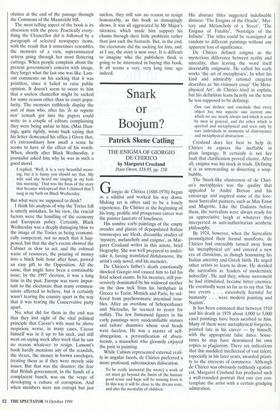Snark or Boojum?
Patrick Skene Catling
THE ENIGMA OF GIORGIO DE CHIRICO by Margaret Crosland Peter Owen, 418.95, pp. 158
Giorgio de Chirico (1888-1978) began as a nihilist and worked his way down. Making art is often said to be a lonely experience. De Chirico at the beginning of his long, prolific and prosperous career was the painter laureate of loneliness.
His sombre early paintings of the empty arcades and plazas of depopulated Italian townscapes are bleak, dreamlike studies of 'mystery, melancholy and enigma', as Mar- garet Crosland writes in this astute, brief biography. She was well prepared to under- take it, having translated Hebdomeros, the artist's only novel, and his memoirs.
De Chirico's father's death emotionally shocked Giorgio and caused him to fail his final school exams. In his twenties, still pos- sessively dominated by his widowed mother on the slow trek from his birthplace in Greece to Turin, Munich and Paris, he suf- fered from psychosomatic intestinal trou- bles. After an overdose of Schopenhauer and Nietzsche, he seemed to yearn for nullity. The few humanoid figures in his early paintings were unidentifiable statues and tailors' dummies whose oval heads were faceless. He was a master of self- abnegation, a personification of absen- teeism, a masochist who gloomily enjoyed the pain in painting.
While Cubists represented extemal reali- ty in angular facets, de Chirico preferred a more profound, subconscious dislocation.
To be really immortal [he wrote] a work of art must go beyond the limits of the human: good sense and logic will be missing from it. In this way it will be close to the dream state, and also the mentality of children.
His abstract titles suggested indefinable distress: 'The Enigma of the Oracle', 'Mys- tery and Melancholy of a Street', 'The Enigma of Fatality', 'Nostalgia of the Infinite'. The titles could be reassigned at random to different paintings without any apparent loss of significance.
De Chirico defined enigma as the mysterious difference between reality and unreality, thus leaving the word itself inscrutably enigmatic. He called his early works 'the art of metaphysics'. In what his kind and admirably rational exegetist describes as 'his visionary essay' On Meta- physical Art', de Chirico tried to explain, but his definition leans heavily on the term he was supposed to be defining:
One can deduce and conclude that every object has two aspects: one current one which we see nearly always and which is seen by men in general, and the other which is spectral and metaphysical and seen only by rare individuals in moments of clairvoyance and metaphysical abstraction ...
Crosland does her best to help de Chirico to express the ineffable in plain language. It certainly is not her fault that clarification proved elusive. After all, enigma was his stock in trade. Defining it is as unrewarding as dissecting a soap- bubble.
The Snark-like elusiveness of de Chili- co's metaphysics was the quality that appealed to Andre Breton and his entourage and inspired some of the fore- most Surrealist painters, such as Max Ernst and Magritte. Like the Dadaists before them, the surrealists were always ready for an appreciative laugh at whatever they interpreted as anti-authoritarian aesthetic philosophy.
By 1924, however, when the Surrealists promulgated their formal manifesto, de Chirico had ostensibly turned away from his 'metaphysical art' and entered a new era of classicism, as though honouring his Italian ancestry and Greek birth. He urged other artists to learn to draw. He derided the surrealists as 'leaders of modernistic imbecility'. He and they, whose movement he had stimulated, became bitter enemies. He eventually went so far as to say that 'the two events . . . excessively harmful for humanity . . . were modern painting and Nazism'.
It has been estimated that between 1910 and his death in 1978 about 4,000 to 5,000 easel paintings have been ascribed to him. Many of them were metaphysical forgeries, painted late in his career — by himself, with the appropriate false dates. Some- times he may have denounced his own copies as plagiarism. There are indications that this muddled intellectual of vast talent, especially in his later years, awarded priori- ty to the interests of commerce. Although de Chirico was obviously ruthlessly egotisti- cal, Margaret Crosland has produced such a well-rounded portrait that one can con- template the artist with a certain grudging admiration.


















































































 Previous page
Previous page